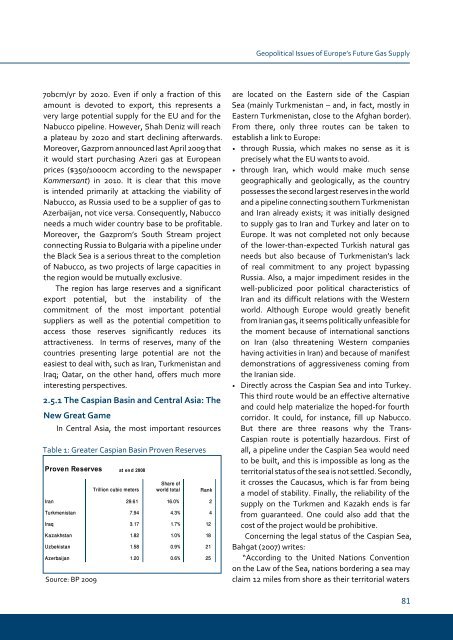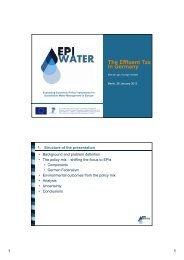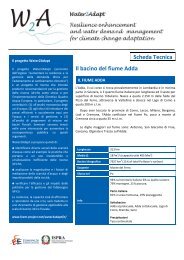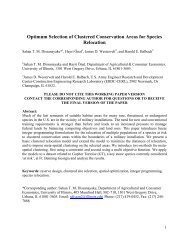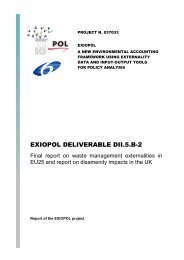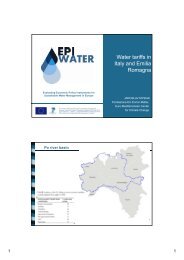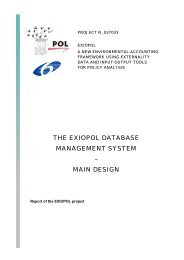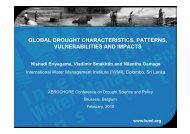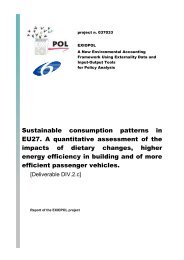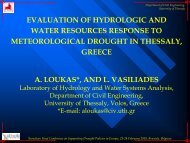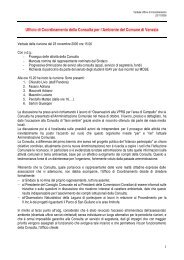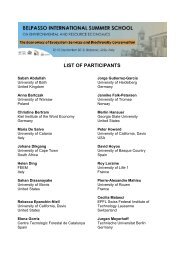Gulf and European Energy Supply Security - Feem-project.net
Gulf and European Energy Supply Security - Feem-project.net
Gulf and European Energy Supply Security - Feem-project.net
Create successful ePaper yourself
Turn your PDF publications into a flip-book with our unique Google optimized e-Paper software.
70bcm/yr by 2020. Even if only a fraction of this<br />
amount is devoted to export, this represents a<br />
very large potential supply for the EU <strong>and</strong> for the<br />
Nabucco pipeline. However, Shah Deniz will reach<br />
a plateau by 2020 <strong>and</strong> start declining afterwards.<br />
Moreover, Gazprom announced last April 2009 that<br />
it would start purchasing Azeri gas at <strong>European</strong><br />
prices ($350/1000cm according to the newspaper<br />
Kommersant) in 2010. It is clear that this move<br />
is intended primarily at attacking the viability of<br />
Nabucco, as Russia used to be a supplier of gas to<br />
Azerbaijan, not vice versa. Consequently, Nabucco<br />
needs a much wider country base to be profitable.<br />
Moreover, the Gazprom’s South Stream <strong>project</strong><br />
connecting Russia to Bulgaria with a pipeline under<br />
the Black Sea is a serious threat to the completion<br />
of Nabucco, as two <strong>project</strong>s of large capacities in<br />
the region would be mutually exclusive.<br />
The region has large reserves <strong>and</strong> a significant<br />
export potential, but the instability of the<br />
commitment of the most important potential<br />
suppliers as well as the potential competition to<br />
access those reserves significantly reduces its<br />
attractiveness. In terms of reserves, many of the<br />
countries presenting large potential are not the<br />
easiest to deal with, such as Iran, Turkmenistan <strong>and</strong><br />
Iraq; Qatar, on the other h<strong>and</strong>, offers much more<br />
interesting perspectives.<br />
2.5.1 the Caspian Basin <strong>and</strong> Central Asia: the<br />
new Great Game<br />
In Central Asia, the most important resources<br />
Table 1: Greater Caspian Basin Proven Reserves<br />
Proven Reserves at end 2008<br />
Trillion cubic meters<br />
Share of<br />
world total Rank<br />
Iran 29.61 16.0% 2<br />
Turkmenistan 7.94 4.3% 4<br />
Iraq 3.17 1.7% 12<br />
Kazakhstan 1.82 1.0% 18<br />
Uzbekistan 1.58 0.9% 21<br />
Azerbaijan 1.20 0.6% 25<br />
Source: BP 2009<br />
Geopolitical Issues of Europe’s Future Gas <strong>Supply</strong><br />
are located on the Eastern side of the Caspian<br />
Sea (mainly Turkmenistan – <strong>and</strong>, in fact, mostly in<br />
Eastern Turkmenistan, close to the Afghan border).<br />
From there, only three routes can be taken to<br />
establish a link to Europe:<br />
• through Russia, which makes no sense as it is<br />
precisely what the EU wants to avoid.<br />
• through Iran, which would make much sense<br />
geographically <strong>and</strong> geologically, as the country<br />
possesses the second largest reserves in the world<br />
<strong>and</strong> a pipeline connecting southern Turkmenistan<br />
<strong>and</strong> Iran already exists; it was initially designed<br />
to supply gas to Iran <strong>and</strong> Turkey <strong>and</strong> later on to<br />
Europe. It was not completed not only because<br />
of the lower-than-expected Turkish natural gas<br />
needs but also because of Turkmenistan’s lack<br />
of real commitment to any <strong>project</strong> bypassing<br />
Russia. Also, a major impediment resides in the<br />
well-publicized poor political characteristics of<br />
Iran <strong>and</strong> its difficult relations with the Western<br />
world. Although Europe would greatly benefit<br />
from Iranian gas, it seems politically unfeasible for<br />
the moment because of international sanctions<br />
on Iran (also threatening Western companies<br />
having activities in Iran) <strong>and</strong> because of manifest<br />
demonstrations of aggressiveness coming from<br />
the Iranian side.<br />
• Directly across the Caspian Sea <strong>and</strong> into Turkey.<br />
This third route would be an effective alternative<br />
<strong>and</strong> could help materialize the hoped-for fourth<br />
corridor. It could, for instance, fill up Nabucco.<br />
But there are three reasons why the Trans-<br />
Caspian route is potentially hazardous. First of<br />
all, a pipeline under the Caspian Sea would need<br />
to be built, <strong>and</strong> this is impossible as long as the<br />
territorial status of the sea is not settled. Secondly,<br />
it crosses the Caucasus, which is far from being<br />
a model of stability. Finally, the reliability of the<br />
supply on the Turkmen <strong>and</strong> Kazakh ends is far<br />
from guaranteed. One could also add that the<br />
cost of the <strong>project</strong> would be prohibitive.<br />
Concerning the legal status of the Caspian Sea,<br />
Bahgat (2007) writes:<br />
“According to the United Nations Convention<br />
on the Law of the Sea, nations bordering a sea may<br />
claim 12 miles from shore as their territorial waters<br />
1


